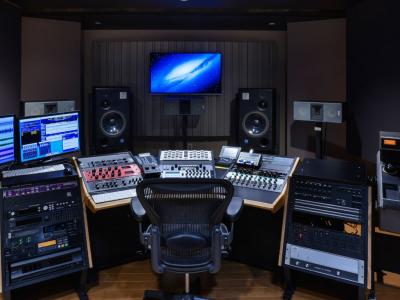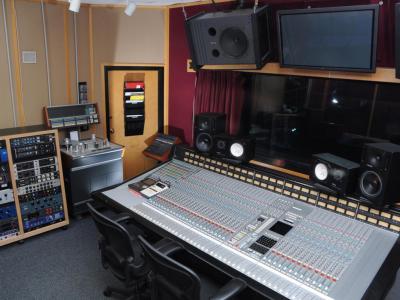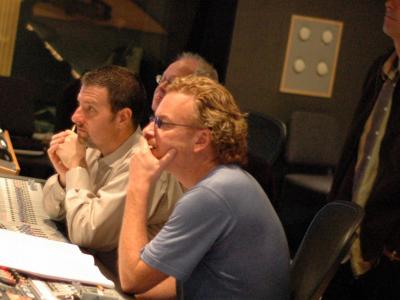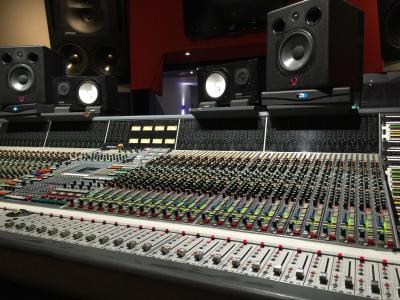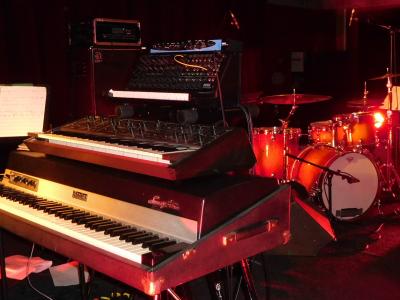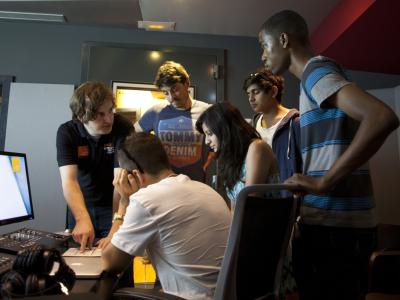Change is the nature of electronic music. To keep pace, the composer must adapt. Composing and Producing Electronic Music is a completely current approach to teaching students the necessary tools and techniques to create contemporary electronic music in a variety of styles, including drum and bass, trance, dub, and house. You will learn the history of electronic music with listening examples that highlight the important people, technology, and techniques associated with the style. The lessons will feature a series of videos describing musical, DAW, and synthesis techniques appropriate to the style. For each style, there will also be a research and analysis component, in which students learn to listen critically and adapt to changes in technology and public musical taste. Students are then responsible for creating a complete piece of music for that style. Work can be done in any major DAW that supports AU, RTAS, or VST instruments, including Pro Tools, Logic, Cubase, Live, or Reason.
This music composition course teaches topics like rhythm and harmony within the framework of a DAW, starting in the first week with an introduction to common scales and rhythms. As the course progresses, the musical examples become more complex as a harmonic language appropriate to the styles is developed. The course takes a similar approach with synthesis, covering the basic concepts of syntheses using a custom-built synthesizer. Quickly, the course moves into Xfer Records Serum synthesizer in order to develop patches appropriate to each style. With a thorough understanding of these patches, you can then apply the same concepts to another synth.
By analyzing and composing in a variety of electronic music styles, you will gain a deep understanding of many aspects of contemporary electronic music, including beats, harmony, bass lines, groove, melodies, synthesis, audio/MIDI editing, effects processing, sound design, form, performance, and mixing.
By the end of the course, you will be able to:
- Compose and produce in various styles of electronic music, including jungle/drum&bass, trance, glitch, dub, electro, minimal, downtempo, house, and techno
- Analyze electronic music to keep up on current trends
- Synthesize the major components of electronic music
- Understand the main aspects of groove
- Build complex and layered drum grooves
- Utilize complex signal flow for creative purposes
- Layer acoustic and electronic elements
- Use automation effectively
- Compose with harmony appropriate to electronic music
- Utilize reverb and delay in multiple contexts
- Create exciting builds and breaks
- Compose and synthesize powerful hooks
- Utilize compressors, gates, and filters with and without sidechain inputs
- Use your sequencer to create complex edits
- Synthesize complex and evolving basses, pads, and leads
- Create a variety of interesting synth gestures
- Use advanced quantization functions to add human feel
- Compose and sequence keyboard parts
- Use delays to create evolving soundscapes
Syllabus
Lesson 1: Introduction to Electronic Music
- Essential DAW Skills
- Adding the Kick
- Adding the Snare
- Adding the Hat
- Adding Percussion
- Workshop: MIDI Note Editing
- Workshop: Adding the Pad
- Workshop: Automation
- Adding the Lead
- Workshop: Mixing and Exporting
- Workshop: Key Command Worksheet
- Discussion: Music Production Resources
- Sound and Synthesizer Basics
- Filter
- Envelope
- More on Envelopes
- LFO
- Synth Building Blocks
- Signal Flow Basics
- Rhythm Basics
- Swing
- Assignment 1: Compile the Week 1 Demo Project
Lesson 2: Drum and Bass I: Groove Creation
- History of Drum and Bass
- Discussion: Drum and Bass artists
- Drum and Bass Tune Analysis ; Add Additional Rhythmic analysis
- Drum and Bass Survey ; Expand Survey to include more specifics
- Important Rhythmic Terms
- Sequencing Drum Grooves
- Assignment 2: Drum and Bass 1 - Sequence a Drum and Bass style groove
Lesson 3: Drum and Bass II: Groove Manipulation
- Drum and Bass Resources and Techniques
- Manipulating Grooves
- Audio Editing
- Sampling
- Workshop: Kick Synthesis
- Discussion: Share Your Kick
- Submixing: Layering Electronic and Acoustic Drums
- Creating a Submix
- Assignment 3: Drum and Bass 2 - Build a Layered Drum and Bass Groove and Configure a Submix
Lesson 4: Drum and Bass III : Bassline
- Consonance, Complexity, Intervals, and Emotion
- Drum and Bass Harmony
- Scale
- The A Aeolian Scale
- Scale with Intervals
- Workshop: Under Your Fingers and In Your Ears
- Quiz: Aeolian Mode
- Massive Signal Flow
- Synthesizing a Sub Bass Sound
- Composing Drum and Bass Bass Lines
- Discussion: Share Your Sub Bass
- Assignment 4: Drum and Bass - Complete Your Drum and Bass Project
Lesson 5: Dub: Automation
- History of Dub
- Discussion: Artists, Resources, and Techniques of Dub
- Creating a Dub Sound in a DAW
- Automating the DAW for that Dub Sound
- Delay Specifics
- DAW Feedback
- Assignment 5: Dub Techniques
Lesson 6: Trance I: Analysis
- History of Trance
- Discussion: Trance Artists
- Trance Tune Analysis ; add additional form analysis
- Comparative Form Analysis Workshop: Trance Survey
- Trance Groove Analysis
- Trance Technical Analysis
- Discussion: Trance Analysis
- Assignment 6: Trance 1 Trance Form Template
Lesson 7: Fill the Time
- Discussion: Trance Survey Results
- Discussion: Trance Resources and Techniques
- Multiple Synced Delays
- Send/Return Signal Flow (Practical)
- Parallel Delays
- Trance Bass Synthesis and Composition
- Discussion: Share your Trance Bass
- Dynamics Processing
- Assignment 7: Trance 2 Development
Lesson 8: Trance III: Lead
- Trance Tune Analysis 2
- Build-Up Techniques
- White Noise Sweep
- Reverse Sounds
- Trance Lead Synthesis
- Share your Trance Lead
- Trance Hook Composition
- Sidechain Compression
- Assignment 8: Trance 3 Complete Your Trance Project
Lesson 9: House I: Diatonic Progressions
- History of House
- Discussion: House Artists
- House Form Analysis
- Workshop: House Survey
- Synthesizing a House Organ
- Chord Progressions
- Building Chords
- Composing a House Progression
- Chords and Diatonic Progressions
- Assignment 9: Create House Progression
Lesson 10: House II: Melody
- Discussion: House Survey Results
- Discussion: Your Favorite House Subgenre
- Composing a Melody
- Composing a Countermelody
- Layering a Melody
- Dutch House Lead
- Assignment 10: Compose and Harmonize a Melody
Lesson 11: House III: House Groove
- House Groove Analysis
- Bass Piano Interaction
- House Piano Rhythm
- Complex House Piano Rhythm
- Broken Chords
- Chords to Percussion
- Alternate Chord to Percussion Techniques
- From Loop to Arrangement
- Piano Voicing Techniques
- Building Grooves with Audio
- Assignment 11: Finish House Piece
Lesson 12: Electro/French House: Making it Loud
- History of Electro/French House
- Discussion: Electro Artists, Resources, and Techniques
- Electro Mix Techniques
- Slap Bass Editing
- Exercise: Make Your Own Slap Line
- Bass Interaction
- Chords Sound Design
- Aeolian and Dorian Scales
- Chords and the Dorian Scale
- Outer Voices
- Non-Scale Tones
- Inversion
- Moving Inner Voices
- Kick Sound Design
- Percussion
- Mastering
- Assignment 12: Electro/French House Remix
Requirements
Prerequisites and Course-Specific Requirements
Prerequisite Courses, Knowledge, and/or Skills
Students should be competent in their chosen Digital Audio Workstation (DAW), including the ability to import samples, edit audio, use virtual instruments, add effects, automate, record MIDI, and export a final mix to MP3.
Textbook(s)
- No textbooks required
Media and Subscriptions
- Recommended: Subscription to electronic music sound library, such as Splice, Arcade, etc.
Software
- Full-featured Digital Audio Workstation (DAW), such as Pro Tools (Studio or Ultimate), Logic Pro, Cubase Pro, Ableton Live (Suite or Standard), Reaper, Reason, or FL Studio (Producer or Signature). Note that GarageBand is not acceptable.
- Xfer Records Serum (student discount information available within the course after enrolling)
Hardware
- MIDI controller
- One of the following studio monitoring options (both recommended):
- Studio monitors (pair), such as JBL 305Ps or better, as well as an audio interface and necessary cables
- Over-ear studio headphones, such as Sennheiser HD 600, Sony MDR-7506, Philips SHP9500, Audio-Technica ATH-M50x, etc.
Student Deals
After enrolling, be sure to check out our Student Deals page for various offers on software, hardware, and more. Please contact support@online.berklee.edu with any questions.
General Course Requirements
Below are the minimum requirements to access the course environment and participate in Live Classes. Please make sure to also check the Prerequisites and Course-Specific Requirements section above, and ensure your computer meets or exceeds the minimum system requirements for all software needed for your course.
Mac Users
PC Users
All Users
- Latest version of Google Chrome
- Zoom meeting software
- Webcam
- Speakers or headphones
- External or internal microphone
- Broadband Internet connection
Instructors
Author
Loudon Stearns is an associate professor at Berklee College of Music, a course author and instructor at Berklee Online, and an active media-artist. Within the Contemporary Writing and Production department at Berklee College of Music, he prepares students to work as independent composers and producers in a technology-laden music industry. Online, he focuses on the latest electronic music styles and music-technology innovations, showing students how to analyze contemporary styles and use the latest music technology in their own works. An innovator in both education and art, Loudon authored a Massive Open Online Class, "Introduction to Music Production," that has provided high-quality free education to hundreds of thousands of students, received an award from the University Professional and Continuing Education Association for "Excellence in Teaching" and received the "Excellence in Media Art" award from the Emerson College Visual and Media Art department.
Holding a Bachelor of Music in Contemporary Writing and Production and Bass Performance from Berklee College of Music, and a Master of Fine Arts in Media Art from Emerson College, Loudon pulls from a broad range of skills in the creation of his own multi-media performances that include live music, projection-mapping, dance, visual art and interactivity. Of particular interest is using the entire world as a performance space by using internet streaming to coordinate numerous performers and audiences on vastly different parts of the globe. The technical and aesthetic challenges of this type of performance are new and exciting and require the sort of broad skill-set that Loudon has developed through his extensive institutional and self education in music, sound, performance, motion graphics, photography, programming, and construction. Read Less
Instructor
Kareem Tony Clarke is a DJ, music producer, and label owner. Throughout his career, he has performed at major clubs in New York City, toured US colleges, performed at TEDxBerkleeValencia, played at SXSW 2017, and held DJ residencies in Valencia, Spain. In 2016 he founded the deep house and techno label Digital Den Records with fellow Berklee alum Ian Cahill.
What's Next?
When taken for credit, Composing and Producing Electronic Music 1 can be applied towards the completion of these related programs:
Related Certificate Programs
Related Degree Major
Questions?
Contact our Academic Advisors by phone at 1-866-BERKLEE (U.S.), 1-617-747-2146 (INT'L), or by email at advisors@online.berklee.edu.
